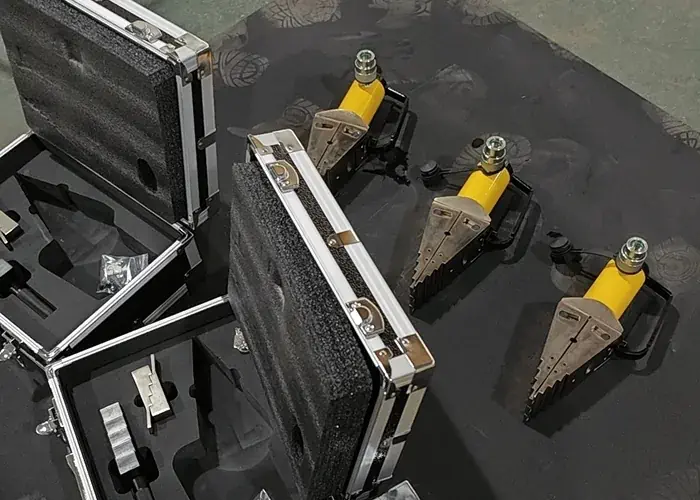Choose the Right Flange Spreader: A Practical Guide for Maintenance Teams
What Is a Flange Spreader and Why SAIVS Recommends It
A flange spreader is a precision tool used to separate pipe flanges safely for gasket replacement, inspection, or alignment.
It creates a controlled gap without damaging flange faces or bolt holes.
SAIVS supplies both mechanical and Hydraulic flange spreaders designed for industrial environments such as oil & gas, power plants, petrochemical, and manufacturing.
Using the correct model reduces downtime, prevents costly flange damage, and improves worker safety.

Mechanical vs Hydraulic Flange Spreaders — which fits your job?
Mechanical Flange Spreaders use ratchet drives and wedge inserts to generate separation force.
They are compact, portable, and ideal for smaller flanges or field work where hydraulic power is not available.
Hydraulic flange spreaders use a pump and cylinder assembly to deliver high, steady spreading force suitable for heavy-duty applications and larger flange sizes.
SAIVS offers both types so you can choose the tool that matches flange geometry, access constraints, and required spread force.
When to choose a mechanical spreader
Choose mechanical spreaders for tight-access locations and jobs that require fast, lightweight tools.
They are well suited to flange sizes where an 18-tonne mechanical capacity is sufficient.
Mechanical spreaders perform well in maintenance tasks that need quick setup and minimal supporting equipment.
When to choose a hydraulic spreader
Hydraulic spreaders are the preferred choice for large-diameter flanges, corroded joints, and heavy industrial systems.
Hydraulic units offer controlled, higher spread forces (for example, 32 tonnes and above) to overcome rusted or stuck flange faces safely.
For repetitive or industrial-scale work, hydraulic spreaders reduce operator fatigue and increase precision.
Key Factors to Choose the Best Flange Spreader
Selecting the right flange spreader requires evaluating flange size, type, spread force, ergonomics, safety features, and accessory options.
Below are the critical selection criteria and how SAIVS addresses them.
1. Flange Size and Type
Match the spreader jaw geometry to the flange profile and bolt circle.
Wedge-style spreaders need an existing gap; step-block or pin-style spreaders suit flanges with limited clearance.
SAIVS provides stepped blocks and interchangeable jaws so one spreader can service a wider range of flange sizes.
2. Spread Force and Capacity
Calculate the minimum spreading load required to open the flange without over-stressing the flange material.
Hydraulic spreaders commonly start at higher-rated capacities than mechanical ones and are adjustable via pump control.
SAIVS labels each model with rated tonne capacity and provides guidance for common flange classes to help you choose correctly.
3. Ease of Use and Ergonomics
Operator comfort reduces error and speeds up work cycles.
Look for anti-slip grips, lightweight alloys, and compact designs that simplify setup in confined spaces.
SAIVS ergonomics prioritize single-handed positioning and quick-release features for faster positioning and removal.
4. durability and Safety Features
A quality spreader is constructed from heat-treated and forged steel components to resist bending and wear.
Important safety features include pressure-relief valves for hydraulic units, safety lanyard attachment points for overhead work, and protected hydraulic hoses.
SAIVS spreaders are tested to industry tolerances and include clear safety labels and maintenance guidance to extend tool life.
5. Versatility and Accessories
Choose a spreader that can be adapted to multiple jobs through accessories like stepped blocks, extension jaws, alignment pins, and carry cases.
SAIVS packages often include modular kits so teams can manage a broader range of flange diameters with fewer base tools.
How to Use a Flange Spreader Safely and Effectively
Follow best practices to protect personnel and equipment when separating flanges.
Proper training, PPE, and inspection routines are as important as tool selection.
Preparation and PPE
Always wear appropriate PPE such as safety glasses, gloves, and steel-toed boots.
Confirm the pipe system is isolated and de-pressurized and that valves and anchors are secured before prying a flange open.
Use flange supports if the gasket removal will temporarily leave the flange unsupported.
Alignment and Gradual Application of Force
Align the spreader with flange bolt holes and seat wedges or pads evenly.
Apply force gradually to avoid sudden separation that could damage bolt holes or gasket surfaces.
Hydraulic users should operate the pump at low pressure initially and increase slowly while checking flange behavior.
Never Exceed Rated Capacity
Overloading a spreader risks catastrophic failure and severe injury.
Refer to SAIVS capacity charts and do not improvise with adapters that compromise rated load paths.
If a flange will not separate within the spreader’s rated range, reassess the situation with heating, corrosion removal, or cutting and replacement methods.
Maintenance and Post-Use Care
Inspect the spreader after each use for wear, cracks, or hydraulic leaks.
Clean off corrosion and lubricate moving parts per the SAIVS maintenance schedule.
Store hydraulic pumps and hoses in dry conditions and replace seals on schedule to prevent contamination and failure.
Why Buy SAIVS Flange Spreaders
SAIVS combines robust engineering, modular accessories, and clear safety documentation to deliver tools suited for plant maintenance and field service.
Our product range covers light mechanical spreaders for maintenance crews and high-capacity Hydraulic Systems for industrial contractors.
Choosing SAIVS reduces tool count, speeds service windows, and lowers the risk of flange damage—helping you finish jobs faster and safer.
Call to Action
If you need assistance selecting the correct flange spreader model for your flange class, pipe size, and working environment, contact SAIVS technical sales for a tailored recommendation.
Our specialists can provide spec sheets, load charts, and accessory kits to ensure your team has the safest and most efficient tools for the job.
Why Choose SAIVS™ as Your Supplier?
With 20 years of industry experience, SAIVS is a leading Chinese manufacturer of high-quality tools, offering competitive pricing and excellent customer service.We pride ourselves on exceptional quality control, extensive experience, and comprehensive after-sales service.